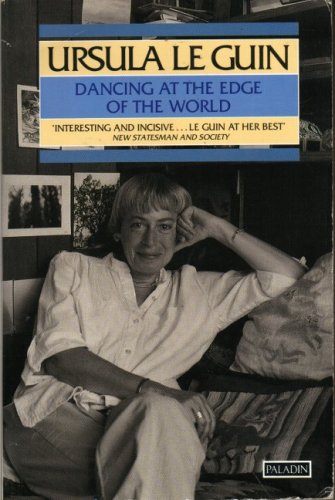 Dancing at the Edge of the World, Ursula Le Guin
Dancing at the Edge of the World, Ursula Le Guin
Review from October 12, 2012
I think Ursula Le Guin’s collections of essays were the first non-fictional works that I really learned to appreciate. I was very much not a non-fiction person at the time, but Le Guin’s writing is always so full of clarity, so well considered, that it draws me in when it’s non-fiction as surely as when it’s prose.
Obviously some of these essays are somewhat dated now, written and edited in the 70s and 80s, but there’s still a lot of interest there. Le Guin’s thoughts on the gender issues in The Left Hand of Darkness, for example, years after it was published, years after she originally wrote about it, for example. Or her reflections on her mother’s life, or on Jo March as one of the few female writers in fiction to be a writer and have a family at the same time… A personal gem for me was coming across, in the section containing book reviews, a review of C.S. Lewis that almost inevitably also reflected on J.R.R. Tolkien:
J.R.R. Tolkien, Lewis’s close friend and colleague, certainly shared many of Lewis’s views and was also a devout Christian. But it all comes out very differently in his fiction. Take his handling of evil: his villains are orcs and Black Riders (goblins and zombies: mythic figures) and Sauron, the Dark Lord, who is never seen and has no suggestion of humanity about him. These are not evil men but embodiments of the evil in men, universal symbols of the hateful. The men who do wrong are not complete figures but complements: Saruman is Gandalf’s dark-self, Boromir Aragorn’s; Wormtongue is, almost literally, the weakness of King Theoden. There remains the wonderfully repulsive and degraded Gollum. But nobody who reads the trilogy hates, or is asked to hate, Gollum. Gollum is Frodo’s shadow; and it is the shadow, not the hero, who achieves the quest. Though Tolkien seems to project evil into “the others”, they are not truly others but ourselves; he is utterly clear about this. His ethic, like that of dream, is compensatory. The final “answer” remains unknown. But because responsibility has been accepted, charity survives. And with it, triumphantly, the Golden Rule. The fact is, if you like the book, you love Gollum.
In Lewis, responsibility appears only in the form of the Christian hero fighting and defeating the enemy: a triumph, not of love, but of hatred. The enemy is not oneself but the Wholly Other, demoniac.
I’m not sure I agree with all of that — the Southrons are most definitely Othered, and I’m not sure they’re meant to be universal symbols of the hateful. Or rather, if they are, and perhaps they are, we need to examine why Tolkien made that decision. But I do think that this is an informative way of looking at the two authors, which reflects a lot on Le Guin herself as well.
Rating: 5/5

That is a really interesting perspective on the two series, even if like you say there may be some not so grey area in Tolkien’s world as well.
Yeah, Le Guin’s perspective on Tolkien really reinvigorated his work for me, not just in this collection but in a couple of her other essays/collections. She has a great way of looking at it.
Woah, this sounds intense and very interesting! I’ve never really thought or analysed Tolkien’s work, though, because I only read book 1 of LOTR and then just abandoned and watched the movies. Aren’t I bad?! >->
It is! I’m a big nerd about Tolkien — did part of my MA on his work — so… heh. But I don’t think you’re bad for not being interested!